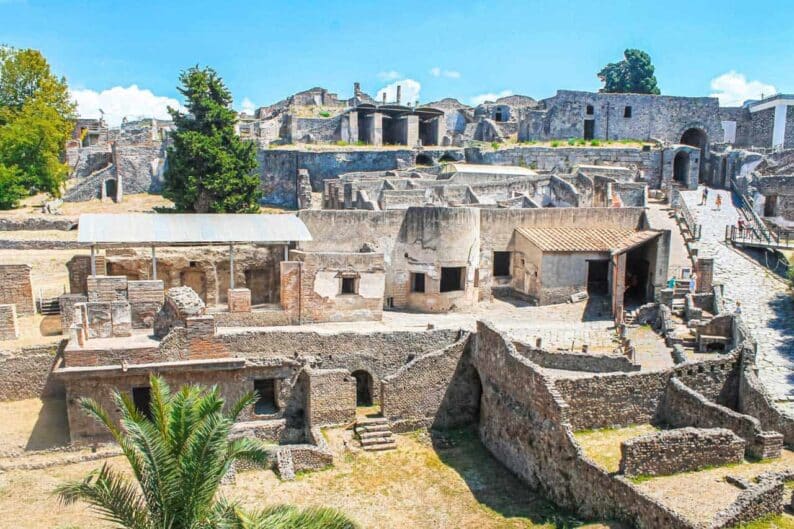Pompeii was a thriving ancient Roman city located near modern-day Naples, Italy. It was buried under volcanic ash and pumice following the eruption of Mount Vesuvius in 79 AD, which led to its preservation and later excavation.
At the time of its destruction, Pompeii was a prosperous city with a population of approximately 11,000 people. It was known for its advanced water system, amphitheaters, public baths, and beautiful homes with intricate mosaics and frescoes.
Following the eruption, Pompeii was forgotten for centuries and eventually covered by layers of ash and soil. It wasn’t until the 18th century that the city was rediscovered, and since then, it has been one of the most important archaeological sites in the world, offering insight into daily life in ancient Rome.
History of Pompeii
Pompeii History was a prosperous ancient Roman city located near modern-day Naples, Italy. Founded by the Osci in the 8th century BC, it grew and prospered under Greek and Roman rule, becoming an important trading hub. During the first century AD, Pompeii was a bustling city known for its impressive public works, advanced water system, amphitheaters, public baths, and beautiful homes with intricate mosaics and frescoes.
On August 24, 79 AD, disaster struck when Mount Vesuvius erupted, burying the city in volcanic ash and pumice. It is estimated that the eruption killed thousands of people and left the city buried under up to 20 feet of debris. Pompeii was forgotten for centuries and eventually covered by layers of ash and soil. It wasn’t until the 18th century that the city was rediscovered, and since then, it has been one of the most important archaeological sites in the world, offering insight into daily life in ancient Rome. Excavations of Pompeii began in the mid-18th century and have continued to the present day, revealing many well-preserved buildings, streets, and artifacts. Today, Pompeii is a UNESCO World Heritage Site and a popular tourist attraction.

How to Reach
Pompeii is located near Naples, Italy, and can be easily reached by various modes of transportation.
By Train:
The most convenient way to reach Pompeii is by train. There are two train stations near Pompeii: the Pompei Scavi Station and the Pompei Station. The Pompei Scavi station is closest to the archaeological site, while the Pompei station is a bit further away. Both stations can be reached from Naples, Sorrento, and other nearby towns.
By Bus:
Buses are also available to reach Pompeii from Naples and other nearby towns. The SITA bus company operates regular bus services to Pompeii from Naples and other destinations.
By Car:
If you prefer to drive, Pompeii can be reached via the A3 motorway, which connects Naples and Salerno. The Pompeii exit is clearly marked on the motorway.
Best Time to Visit Pompeii
The best time to visit Pompeii is during the spring (April to June) and fall (September to November) when the weather is mild, and there are fewer crowds. The summer months (July and August) can be extremely hot and crowded, making it less enjoyable to explore the ancient ruins. Additionally, many Italians take their summer holidays during August, which can result in longer wait times and crowds.
Visiting Pompeii in the winter (December to February) can also be a good option, as the crowds are smaller, and the weather is cooler. However, keep in mind that it can rain frequently during this time of year, so be prepared with appropriate clothing. It’s also worth considering visiting Pompeii during the week instead of on weekends, as weekends tend to be busier with both tourists and locals visiting. Additionally, visiting early in the morning or later in the afternoon can help you avoid the peak crowds.
Tips to Visit Pompeii
Here are some tips to help you make the most of your visit to Pompeii:
Wear comfortable shoes: The ancient city of Pompeii is spread across a large area, and you’ll be walking a lot, so it’s important to wear comfortable shoes.
Bring water: It can get hot and humid in Pompeii, especially during the summer months, so be sure to bring plenty of water to stay hydrated.
Hire a guide or audio guide: Pompeii is a vast site with many ruins and artifacts, and having a guide or audio guide can provide a deeper understanding of the site’s history and significance.
Visit early or late in the day: Visiting early in the morning or later in the afternoon can help you avoid the peak crowds and heat.
Be mindful of pickpockets: Like any busy tourist attraction, pickpockets can be a problem at Pompeii. Keep your valuables close and be aware of your surroundings.
Respect the site: Pompeii is an ancient archaeological site, so it’s important to be respectful of the ruins and artifacts. Don’t climb on or touch the ruins, and be sure to follow any posted rules or regulations.
Plan ahead: Pompeii is a popular tourist attraction, so it’s a good idea to book tickets and tours in advance to avoid long wait times.
Things to Do in Pompeii
There are many things to do in Pompeii that will allow you to explore the ancient ruins and learn about the city’s history. Here are some of the top things to do in Pompeii:
Explore the ruins: Pompeii is an ancient city that was buried in ash after the eruption of Mount Vesuvius, and today, the ruins offer a glimpse into life during ancient Roman times. You can explore the streets, homes, public buildings, and temples that have been preserved for over 2,000 years.
Visit the Forum: The Forum was the center of Pompeii’s public life, and it’s where the city’s most important buildings were located, including the Basilica and the Temple of Jupiter. You can explore the Forum and see the ruins of these important buildings.
See the plaster casts: When Pompeii was excavated, archaeologists found many human and animal remains, which they were able to preserve by pouring plaster into the cavities left by the bodies. You can see these plaster casts in various locations throughout the site.
Visit the Amphitheater: The Amphitheater is one of the best-preserved buildings in Pompeii and was used for gladiatorial contests and other events. You can explore the seating areas and imagine what it was like to be a spectator during these events.















